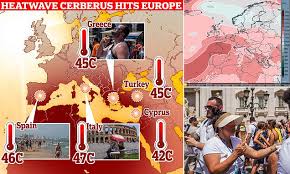Urban centers are on the frontlines of climate change, facing heightened risks from natural disasters, rapid population growth, and deepening socio-economic inequalities.
Each year, approximately 70 million people migrate to cities in the developing world, placing immense pressure on infrastructure and straining the delivery of essential services. Many cities struggle to meet these demands in a sustainable and inclusive manner.
Yet, a growing number are rising to the challenge by embracing forward-thinking strategies. Through inclusive community engagement, the adoption of nature-based solutions, innovative governance frameworks.
And the integration of digital technologies, these cities are transforming into global models of resilience, sustainability, and equity—proving that with the right approach, urban development can be both adaptive and inclusive in the face of accelerating change.
Read More: Top 5 Cities Championing Resilience, Sustainability, and Inclusivity
Bonn, Germany: Advancing Climate Ambitions Through Community Insight and Engagement
With over 300,000 residents, Bonn has emerged as a leading international center for sustainable urban development, setting an ambitious target of achieving climate neutrality by 2035.
This commitment is underpinned by a wide array of initiatives, supported through various funding programs, that focus on energy efficiency, green infrastructure, and climate risk mitigation—particularly concerning floods and heatwaves.
A cornerstone of Bonn’s climate strategy is inclusive participation. The city’s Climate Action Plan was developed in close collaboration with citizens, civil society, and businesses. Additionally, “climate districts” are being established to foster grassroots engagement.
Public surveys regularly assess local knowledge and perceptions, ensuring that policy remains responsive, data-driven, and socially anchored.
Buenos Aires, Argentina: Transforming Informal Settlements Through Local Empowerment
In Buenos Aires, approximately 10% of the population—over 300,000 people—live in informal settlements, making inclusive, climate-conscious urban upgrading essential.
The Transformative Urban Coalitions (TUC), supported by UNU-EHS, launched an Urban Lab in Barrio 20, leveraging existing community networks to co-design and implement initiatives.Projects such as greening schoolyards and installing temperature and humidity monitoring systems have enhanced local resilience.
Rapid integration of the Urban Lab into the community’s broader upgrading strategy has strengthened ownership and sustained engagement. Villa 20 stands as a compelling example of how participatory urban processes can foster greener, more equitable living conditions.
Hue, Viet Nam: Building Flood Resilience Through Adaptation and Nature-Based Solutions
Situated in flood-prone Central Viet Nam, Hue is increasingly exposed to climate-induced flooding. The city initially prioritized infrastructure-based solutions such as dams, drainage systems, and early warning mechanisms.
In recent years, however, it has also embraced nature-based solutions, including mangrove restoration, which has proven highly effective in reducing flood impacts.
UNU-EHS, through the FloodAdaptVN project, plays a key role in these resilience efforts by identifying key flood risks and understanding community needs and perceptions.
These insights are shared with local stakeholders to inform collaborative decision-making, further enhancing the city’s adaptive capacity and reinforcing both structural and ecosystem-based responses.
Nairobi, Kenya: Addressing Urban Vulnerability Through Data and Localized Support
In Nairobi, nearly 60% of the population resides in informal settlements, with Kibera among the most prominent. These communities face escalating threats from climate change and recurring natural hazards.
Although NGOs and government actors provide assistance, the scale and speed of urbanization outpace available resources.Community-led initiatives and local knowledge are proving vital in sustaining livelihoods, particularly during crises.
Data collection efforts—including mapping damage to homes, health, and finances—are crucial.
A UNU-EHS study has amplified these local insights, aligning them with global conversations around the operationalization of the “Loss and Damage Fund,” designed to support those bearing the brunt of unavoidable climate impacts.
Visakhapatnam, India: Leveraging Technology and Participation for Urban Resilience
Located on India’s cyclone-prone eastern coast, Visakhapatnam is a rapidly growing city of 2.3 million residents confronting intense urbanization and climate-related risks, especially pluvial flooding exacerbated by its hilly terrain.
The city’s response has been to harness innovation and inclusive governance.The ‘sachivalayam’ volunteer model is being scaled to train citizens as first responders and active participants in climate resilience.
Supported by app-based tools, these volunteers contribute real-time data to a centralized command and control system, facilitating rapid, informed decision-making.
Through the T-CAP project, UNU-EHS supports an urban living lab that promotes collaboration between residents, volunteers, and local authorities to co-create solutions for risk reduction and climate adaptation.
Frequently Asked Questions (FAQs)
What is the main goal of Bonn’s climate strategy?
Bonn aims to achieve climate neutrality by 2035. Its approach focuses on public participation, green infrastructure, energy efficiency, and mitigating climate-related hazards like heatwaves and flooding.
How does Bonn engage its citizens in climate action?
Bonn involves residents through climate districts, public surveys, and collaborative development of the Climate Action Plan, ensuring policies are inclusive and knowledge-based.
Why are informal settlements a focus in Buenos Aires?
Over 10% of Buenos Aires’ population lives in informal settlements, making it essential to develop participatory and climate-resilient urban upgrading strategies.
What role does the Urban Lab play in Barrio 20, Buenos Aires?
The Urban Lab, supported by the Transformative Urban Coalitions (TUC), empowers local communities to implement green projects and monitoring systems, fostering ownership and resilience.
How is Hue, Viet Nam addressing increased flood risks?
Hue is combining infrastructure-based solutions (e.g. dams, drainage) with nature-based approaches like mangrove restoration. These efforts are supported by community input and risk assessments.
What is the FloodAdaptVN project?
FloodAdaptVN, supported by UNU-EHS, helps Hue build resilience by analyzing flood risks, collecting community feedback, and identifying adaptive, sustainable solutions.
Conclusion
As urban areas continue to expand and face mounting climate challenges, cities like Bonn, Buenos Aires, Hue, Nairobi, and Visakhapatnam offer valuable lessons in resilience, sustainability, and inclusivity. Their diverse approaches—ranging from participatory planning and community-driven upgrades to nature-based solutions and digital innovation—demonstrate that no single strategy fits all.

